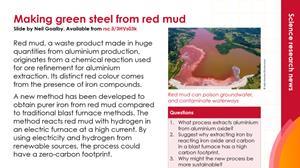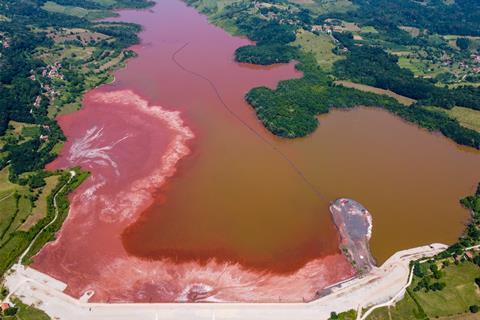Turning hazardous red mud into a sustainable way to make valuable resources
-

Download this
Use this story and the accompanying summary slide for a real-world context when teaching metal extraction and sustainability with your 14–16 learners.
Download the story as MS Word or pdf and the summary slide as MS PowerPoint or pdf.
Red mud – a strongly alkaline, potentially toxic waste material generated in huge quantities during aluminium production – can now be transformed into a green source of iron suitable for use in steelmaking. This novel method has the potential to increase the sustainability of two major metal industries.
Aluminium and steel are two of the most in-demand materials globally, used in everything from construction and vehicle parts to food packaging.
Global aluminium production generates 180 million tonnes of the waste material red mud each year. Currently, only 3% of red mud is recycled. The vast majority ends up in landfills which pose a significant threat to the environment. In 2010, a basin in Hungary filled with red mud collapsed, causing 10 deaths and costing nearly £100 million to clean up.
The exact composition of red mud varies but it always contains plenty of iron oxide – with the iron being the source of the red colour. Iron manufacture is currently fuelled by coal, making the process a significant source of carbon dioxide emissions into the atmosphere. To make steel, iron is alloyed with carbon.

Benefits on two fronts
A carbon-neutral process that releases iron from red mud offers a tantalisingly green way to access steel, while simultaneously removing environmental issues from aluminium production’s problematic waste product.
Dierk Raabe and his team at the Max Planck Institute for Iron Research in Düsseldorf used an ionised gas (a plasma) of hydrogen to turn the iron oxide in the red mud mixture into liquid iron. They did this in an electric arc furnace, which is powered by electricity.
Dierk and his team collected iron that was purer than that produced in the blast furnaces typically used for iron production. The researchers manage to achieve an extraction of about 98% of the iron from the red mud using their method. They also calculated that the process should be economically viable on an industrial scale.
In future, Dierk says he would like to see whether the trace rare earth elements such as yttrium and scandium present in some red mud can also be extracted for reuse.
This article is adapted from Tim Wogan’s in Chemistry World
Nina Notman
Reference
M Jovičević-Klug et al, Nature, 2024, 625, 703–709 (doi.org://10.1038/s41586-023-06901-z)
Download this
Summary slide with questions and the article for context when teaching 14–16 classes on metal extraction and sustainability: rsc.li/3SYlFdE
Downloads
Making green steel from red mud student sheet
Handout | PDF, Size 0.24 mbMaking green steel from red mud student sheet
Handout | Word, Size 1.11 mbMaking green steel from red mud summary slide
Presentation | PDF, Size 0.32 mbMaking green steel from red mud summary slide
Presentation | PowerPoint, Size 2.72 mb









No comments yet